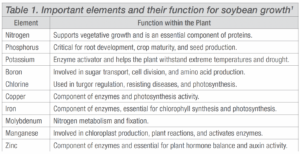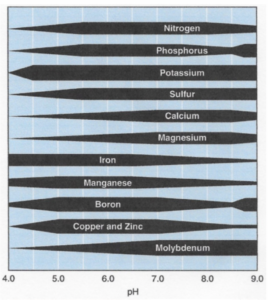Advancements in agronomic, genetic, biological, and crop protection aspects of production have driven increases in soybean yield potential. To maximize this yield potential, it is increasingly important to analyze and maintain soybean fertility. This is not only due to increased soybean yields but also increases in corn yields, environmental concerns, and financial considerations. Due to the nutrients removed when corn is harvested, if the corn crop is larger than expected, it may leave a deficit for some nutrients in the following soybean crop.
Nutrients are the foundation to sustain biological functions, help protect the plant from disease and other stresses, and ultimately support yield (Table 1).1 Soybean plants require 16 elements for growth and seed development. Macronutrients required by soybeans include nitrogen (N), phosphorus (P), and potassium (K). Secondary and micronutrients that aid soybean growth include calcium (Ca), magnesium (Mg), iron (Fe), boron (B), manganese (Mn), zinc (Zn), copper (Cu), molybdenum (Mo), chlorine (Cl), and sulfur (S). Soil pH levels for soybean should be maintained between 5.5 and 7.0 to help maintain overall soil nutrient availability; however, the optimal range is between 6.3 and 6.5. Figure 1 shows how soil pH, which is a measure of soil acidity or alkalinity, affects the availability of various elements.2 Research has also shown that soybean cyst nematode (SCN) populations at harvest are likely to be higher when the soil pH exceeds 6.5. (3)


Figure 1. Nutrient availability based on soil pH. Illinois Agronomy Handbook.
Permission granted for use by Dr. Emerson Nafziger, University of Illinois.
Harvesting a bushel of soybeans removes about 4 lb of N, 0.4 lb of P, 1.25 lb of K, and 0.2 lb of S from the soil (Table 2). Since soybean plants can biologically fix N in their root nodules, P and K have the most potential to be deficient. Each bushel of corn removes less P (about 0.15 lb/bu) and K (about 0.21 lb/ bu) than each soybean bushel; however, as corn yields climb, total nutrient needs increase and more respective nutrient pounds are removed from the system.4 This could potentially leave a soybean crop deficient of P and K. In recent years, 100 plus bu/acre soybean yields have been recorded, making it necessary to be more aware of corn nutrient removals.
Environmentally, if “extra” P is applied for a current crop to fulfill the needs of a future crop, any loss from runoff or soil erosion from topographies may impact bodies of water, resulting in algae blooms. Therefore, it is important to be environmentally responsible with P applications, and, financially, dollars are lost when nutrients are lost to runoff or leaching. Deficiency symptoms may appear on soybean plants if any of the nutrient levels are limited. Generally, deficiencies and the resulting symptoms are rare unless stress from drought, compaction, prolonged saturation, root disease(s), soil insect feeding, pH imbalance, fertilizer burn, or chemical injury to roots cause symptoms to occur. Iron deficiency chlorosis (IDC) is a common disorder appearing in high pH soils (above 7.0) and soils with high sodium (Na) and calcium (Ca) content. Symptoms of IDC include yellowing between the veins of the newest leaves and reduced nodulation and N fixation.
Seedling soybean plants may show P deficiency symptoms (stunting, smaller leaves, interveinal reddening or purpling on lower leaves) when soils are cool and wet, compaction restricts roots, or roots are injured by insects, fertilizer, or chemicals. Because of the high demand for K in soybean, it can often be the most commonly occurring deficiency. Potassium deficiency symptoms can occur in the early growth stages and can be confused with IDC. The contrast between the two is the chlorosis or yellowing of the leaf tissue is at the leaf margins with a K deficiency, whereas with IDC, the yellowing is between the veins, and under extreme conditions there is necrosis or browning of the interveinal area. Potassium deficiency symptoms can also become visible during the reproductive stages, and while the reason for this is not entirely clear, it may be due to the amount of K translocated from the middle or upper leaves into the developing grain in high yield situations.(8)
Soil Nutrient Testing
The first step to determine the availability of soil nutrients is to collect soil samples for nutrient and agronomic testing. Ideally, a test should be conducted every two to three years, and sampling should be completed near the same time of the season for consistency.6 If maintenance fertilizers are not annually applied, soil testing should be completed every other year.2 Soil tests should include an analysis for macro and micronutrients, soil pH, buffer pH, organic matter, and cation exchange capacity (CEC).
Lime and pH
Based on the soil buffer pH test, lime applications, if needed, add Ca and help neutralize soil acidity. When soil pH is maintained between 5.5 and 7.0, a) nutrient availability is enhanced, b) microbial breakdown of crop residue increases, and c) N fixation is optimized .7 Lime dissolves slowly; therefore, applications should occur about 3 to 6 months before planting. Additionally, lime should be applied one month or more before the application of other nutrients because lime can interfere with the availability of other nutrients, especially P. Lime sources should be evaluated because lime products differ in their neutralizing efficiency based on calcium carbonate equivalency and particle size.
Nitrogen
As legumes, soybean plants form root nodules in which N from the air is fixed into ammonia (NH3) by the rhizobia bacteria, Bradyrhizobium japonicum present in the nodules. Ammonia is a form of N that can be readily used by the soybean plant and is the primary N source for soybean. On average, about 55% of the required N is supplied by fixation. However, residual nitrate and mineralized N from soil organic matter are also used, particularly in the first three to four weeks after emergence because nodules are just forming. The soil must contain a healthy supply of the bacteria for nodules to form and produce N. If a soybean crop has not been grown in a field within three to five years, been flooded, or the field has a course soil texture, consideration should be given to inoculating the seed with living B. japonicum. Inoculated seed and inoculants are living organisms and should be handled and stored with care because they can be killed by desiccation, direct sunlight, heat, caustic fertilizers, and pesticides. If a field has high residual N, nodules may be slow to form because the plants are using the residual supply. In some cases, such as during hot dry weather, the rhizobia may not colonize the soybean root and N may be limited, thus reducing yield. Additional N can be applied if there are fewer than 7 nodules per plant. Only nodules that are about 1/16 of an inch in diameter and are pink or red on the inside should be counted. Research has shown that applying 60 to 70 pounds of N per acre can correct the N deficiency and provide an economic return, up to 10 bushels per acre, if applied at the correct time. Ideally, the supplemental N should be applied between the R1 (one open flower on 50 percent of the plants) and R2 growth stages.9 Foliar applications of macronutrients other than N can be beneficial in nutrient-limited conditions, such as sandy soils or in high yielding irrigated fields, if they are applied at early vegetative growth stages and may increase yield by 15 to 20%.5 Some studies suggest that soybean yield can be increased by foliar applications of deficient nutrients between beginning seed (R5) and full seed (R6) growth stages.5 However, many on-farm trials showed that foliar applications produced inconsistent results, and even decreased yields in some areas.5 Foliar fertilizers should be applied at low rates and during periods of cooler, day-time temperatures to help avoid damage to plant tissues.
